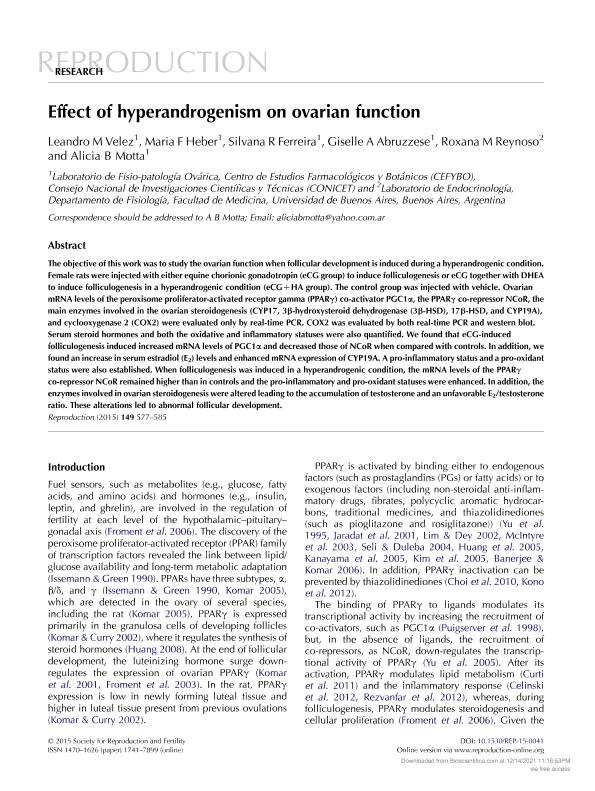Artículo
Effect of hyperandrogenism on ovarian function
Velez, Leandro Martin ; Heber, María Florencia
; Heber, María Florencia ; Ferreira, Silvana Rocio
; Ferreira, Silvana Rocio ; Abruzzese, Giselle Adriana
; Abruzzese, Giselle Adriana ; Reynoso, Roxana M.; Motta, Alicia Beatriz
; Reynoso, Roxana M.; Motta, Alicia Beatriz
 ; Heber, María Florencia
; Heber, María Florencia ; Ferreira, Silvana Rocio
; Ferreira, Silvana Rocio ; Abruzzese, Giselle Adriana
; Abruzzese, Giselle Adriana ; Reynoso, Roxana M.; Motta, Alicia Beatriz
; Reynoso, Roxana M.; Motta, Alicia Beatriz
Fecha de publicación:
06/2015
Editorial:
BioScientifica
Revista:
Reproduction
ISSN:
1470-1626
e-ISSN:
1741-7899
Idioma:
Inglés
Tipo de recurso:
Artículo publicado
Clasificación temática:
Resumen
The objective of the present work was to study the ovarian function when follicular development is induced during a hyperandrogenic condition. Female rats were injected either with chorionic gonadotropin (eCG group) to induce folliculogenesis or with eCG together with dehydroepiandrosterone to induce folliculogenesis in a hyperandrogenic condition (eCG+HA group). The control group was injected with vehicle. Ovarian mRNA levels of the PPARγ co-activator PGC1-α, the PPARγ co-repressor NCoR, and the main enzymes involved in the ovarian steroidogenesis (CYP17, 3β hydroxysteroid dehydrogenase (3β-HSD), 17β hydroxysteroid dehydrogenase (17β-HSD) CYP19A), and cyclooxygenase 2 (COX-2) were evaluated by real time polymerase chain reaction and protein expression of COX-2 was evaluated by Western Blotting. Ovarian steroidogenesis and both the oxidative and inflammatory status were also quantified. We found that eCG-induced folliculogenesis induced increased mRNA levels of PGC1-α and decreased those of NCoR as compared to controls. In addition, we found accumulation of estradiol and enhanced mRNA expression of CYP19A. A pro-inflammatory and a pro-oxidant status were also established. When folliculogenesis was induced in a hyperandrogenic condition, the mRNA levels of the PPARγ co-repressor NCoR remained higher than in controls and the pro-inflammatory and pro-oxidant status were enhanced. In addition, the enzymes involved in ovarian steroidogenesis were altered leading to the accumulation of testosterone and an unfavorable estradiol/testosterone ratio. These alterations led to abnormal follicular development.
Palabras clave:
Hyperandrogenism
,
Ovary
,
Ppargamma
,
Folliculogenesis
Archivos asociados
Licencia
Identificadores
Colecciones
Articulos(CEFYBO)
Articulos de CENTRO DE ESTUDIOS FARMACOLOGICOS Y BOTANICOS
Articulos de CENTRO DE ESTUDIOS FARMACOLOGICOS Y BOTANICOS
Citación
Velez, Leandro Martin; Heber, María Florencia; Ferreira, Silvana Rocio; Abruzzese, Giselle Adriana; Reynoso, Roxana M.; et al.; Effect of hyperandrogenism on ovarian function; BioScientifica; Reproduction; 149; 6; 6-2015; 577-585
Compartir
Altmétricas



